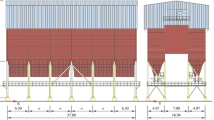Abstract
A linear response history analysis method is used to determine the influence of three factors: geometric incoherency, wave-passage, and local site characteristics on the response of multi-support structures subjected to differential ground motions. A one-span frame and a reduced model of a 24-span bridge, located in Las Vegas, Nevada are studied, in which the influence of each of the three factors and their combinations are analyzed. It is revealed that the incoherency of earthquake ground motion can have a dramatic influence on structural response by modifying the dynamics response to uniform excitation and inducing pseudo-static response, which does not exist in structures subjected to uniform excitation. The total response when all three sources of ground motion incoherency are included is generally larger than that of uniform excitation.
Similar content being viewed by others
References
Abdel-Ghaffar A and Nazmy AS (1991) “3-D Nonlinear Seismic Behavior of Cable-Stayed Bridge,” Journal of Structural Engineering, ASCE, 117(11): 3456–3476.
Abrahamson NA, Bolt BA, Darragh RB, Penzien J and Tsai Y B (1987) “The SMART-1 Accelerograph Array (1980-1987): A Review,” Earthquake Spectra, 3: 267–287.
Banerji P, Murudi MA, Shah and Popplewell N (2000), “Tuned Liquid Dampers for Controlling Earthquake Response of Structures,” Earthquake Engineering and Structural Dynamics, 29: 587–60
Behnamfar F and Sugimura Y (1999) “Dynamic Response of Adjacent Structures Under Spatially Variable Seismic,” Probabilistic Engineering Mechanics, 14: 33–44.
Beresnev IA, Wen L and Yeh YT (1994) “Source, Path and Site Effects on Dominant Frequency and Spatial Variation of Strong Ground Motion Recorded By SMART1 And SMART2 Arrays in Taiwan,” Earthquake Engineering and Structural Dynamics, 23: 583–597.
Bogdanoff JL, Goldberg JE and Schiff (1965) “The Effect of Ground Transmission Time on The Response of Long Structures,” Bull Seism Soc Am, 55(3): 627–640.
Clough R and Penzien J (1975), Dynamics of structures, McGraw-Hill, New York, N. Y.
Der Kiureghian A (1996) “A Coherency Model for Spatially Varying Ground Motions,” Earthquake Engineering and Structural Dynamics, 25: 99–111.
Ettouney M, Hapij A and Gajer R (2001) “Frequency Domain Analysis of Long-Span Bridges Subjected to Non Uniform Seismic Motions,” J. of Bridge Engineering, 6(6): 577–586.
Griffin G, Saiidi M and Maragakis E (1995), “Nonlinear Seismic Response Analysis of Isolated Bridges with Multiple Columns,” Report No. CCEER-95-6, Engineering Research and Development Center, University of Nevada, Reno.
Hao H (1989), “Effects of Spatial Variation of Ground Motions on Large Multiply-Supported Structures,” Report, UCB/EERC-89/06, University Of California, Berkeley.
Hao H (1998) “Response of Two-Way Eccentric Building to Nonuniform Base Excitations,” Engineering Structures, 20(8): 677–684.
Hao H and Zhang S (1999) “Spatial Ground Motion Effect on Relative Displacement of Adjacent Building Structures,” Earthquake Engineering and Structural Dynamics, 28: 333–349.
Harichandran RS, Hawwari A and Sweiden BN (1996), “Response of Long-Span Bridges to Spatially Varying Ground Motion,” J. of Structural Engineering, 122(5): 476–484.
Joseph I, Sun, R Golesorkhi H and Bolton Seed (1988), “Dynamic Moduli and Damping Ratios for Cohesive Soils,” Report No. UCB/EERC-88/15, University of California, Berkeley.
Kahan M, Gibert R and Bard P (1996) “Influence of Seismic Waves Spatial Variability on Bridges: A Sensitivity Analysis,” Earthquake Engineering and Structural Dynamic, 25(4): 795–814.
Luco JE and Wong LH (1986) “Response of A Rigid Foundation to A Spatially Random Ground Motion,” Earthquake Engineering and Structural Dynamics, 14: 891–908.
Monti G, Nuti C and Pinto P (1996) “Nonlinear Response of Bridges Under Multi-Support Excitation,” J. Structural Engineering, 122(10): 1147–1159.
Nazmy A and Abdel-Ghaffar A (1992) “Effect of Ground Motion Spatial Variability on The Response of Cable-Stayed Bridges,” Earthquake Engineering and Structural Dynamics, 21:1–20.
Ohsaki Y (1979) “On the siginificance of Phase Content in Earthquake Ground Motion,” Earthquake Engineering and Structural Dynamics, 7(5): 427–439.
Perotti F (1990) “Structural Response to Non-Stationary Multiple-Support Random Excitation,” Earthquake Engineering and Structural Dynamics, 19(4): 513–527.
Price T and Eberhard M (1998) “Effects of Spatially Varying Ground Motions on Short Bridges,” J. Structural Engineering, 124(8): 948–955.
Saiidi M, Itani A, Yang Q, and Ladkany S, “Multifaceted Seismic Evaluation and Retrofit Study of A Major Viaduct,” Proceedings, First International Conference and Annual Meeting of Asian-Pacific Network of Centers for Earthquake Engineering Research, Harbin, China, August 2002.
Shrikhande M and Gupta V (1999) “Dynamic Soil-Structure Interaction Effects On The Seismic Response of Suspension Bridges,” Earthquake Engineering and Structural Dynamics, 28: 1383–1403.
Wilson E (2000), Three Dimensional Static and Dynamic Analysis of Structures, A publication of computer and structures. Inc., April.
Yang Q and Chen Y (2000) “A Practical Coherency Model for Spatially Varying Ground Motions,” Structural Engineering and Mechanics, 9(2):141–152.
Yang Q and Jiang H (2001) “Generation of Ground Motion Non-Stationary Both in Time and Frequency Domains Based on Phase Difference Spectrum,” Earthquake Engineering and Engineering Vibration, 21(3): 10–16, Harbin. (in Chinese)
Yang Q, Saiidi M, Wang H and Itani A(2002), “Influences of Earthquake Ground Motion Incoherency on Multi-support Structures,” Report Number CCEER-02-2, Center for Civil Engineering Earthquake Research, Department of Civil Engineering, University of Nevada.
Zerva A (1990) “Response of Multi-Span Beams to Spatially Incoherent Seismic Ground Motions,” Earthquake Engineering and Structural Dynamics, 19: 819–832.
Zhao Fengxin (1992), “The Phase Difference Spectrum of Time Histories and the Generation of the Design Ground Motions”, Ph.D. Dissertation, Institute of Geophysics, China Seismology Bureau(in Chinese).
Author information
Authors and Affiliations
Corresponding author
Rights and permissions
About this article
Cite this article
Yang, Q., Saiidi, M.S., Hang, W. et al. Influence of earthquake ground motion incoherency on multi-support structures. Earthq. Engin. Engin. Vib. 1, 167–180 (2002). https://doi.org/10.1007/s11803-002-0063-4
Issue Date:
DOI: https://doi.org/10.1007/s11803-002-0063-4




